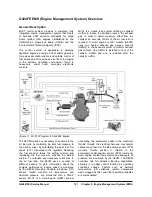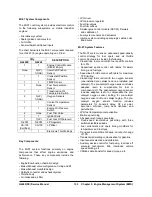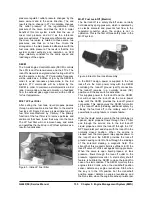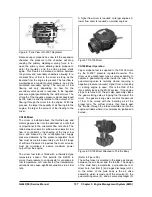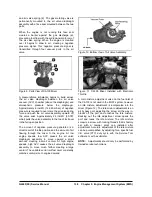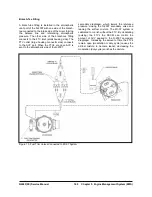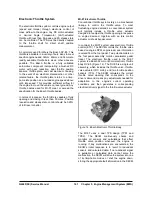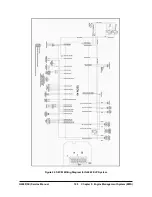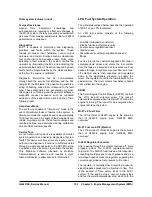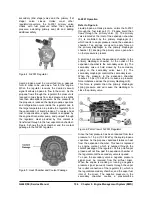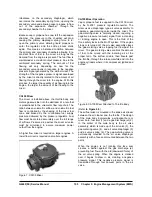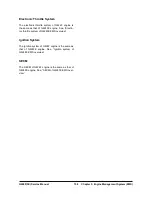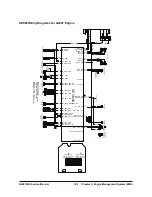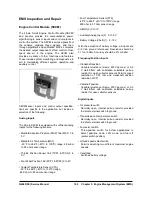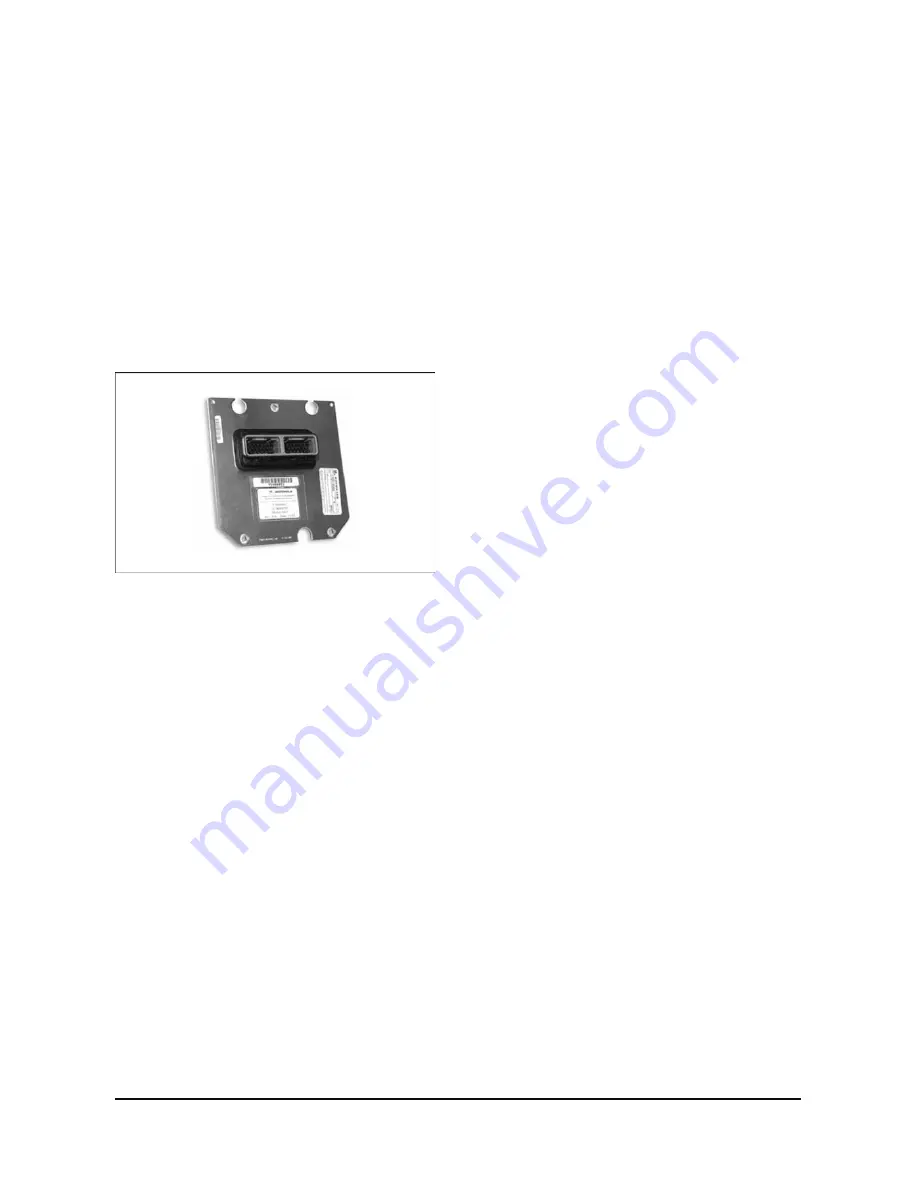
G424F(FE) Service Manual
Chapter 5. Engine Management System (EMS)
145
SECM
General Description
The Small Engine Control Module (SECM) controller
has full authority over spark, fuel and air. Utilizing a
Freescale micro controller, the SECM has 48 pins of
I/O and is fully waterproof and shock hardened. To
optimize engine performance and drivability, the
SECM uses several sensors for closed loop
feedback information. These sensors are used by
the SECM for closed loop control in three main
categories:
• Fuel Management
• Load/Speed Management
• Ignition Management
The SECM monitors system parameters and stores
any out of range conditions or malfunctions as faults
in SECM memory. Engine run hours are also stored
in memory. Stored fault codes can be displayed on
the Malfunction Indicator Light (MIL) as flash codes
or read by the MI-07 Service Tool software through
a CAN (Controller Area Network) communication
link.
Constant battery power (12 Vdc) is supplied through
the fuse block to the SECM and the main power
relays. Upon detecting a key-switch ON input, the
SECM will fully power up and energize the main
power relays.
The energized main power relays supply 12 Vdc
power to the heated element of the oxygen sensors,
fuel lock-off, fuel trim valves (FTVs), gasoline
injectors, gasoline fuel pump, crank sensor, cam
sensor, and the ignition coils.
The SECM supplies voltage to the electronic throttle
actuator, oil pressure switch, fuel temperature
sensor, and the coolant temperature sensor.
Transducer or sensor power (+ 5 Vdc) is regulated
by the SECM and supplied to the manifold
temperature/air pressure (TMAP) sensor, throttle
position sensor (TPS), and the accelerator pedal
position sensors (APP1 & APP2).
The SECM provides a transducer ground for all the
sensors, and a low side driver signal controlling the
fuel lock-off, MIL, gasoline injectors, gasoline fuel
pump, and FTVs.
Fuel Management
During engine cranking at startup, the SECM
provides a low side driver signal to the fuel lock-off,
which opens the lock-off allowing liquid propane to
flow to the N-2007 regulator. A stall safety shutoff
feature is built into the SECM to close the lock-off in
case of a stall condition. The SECM monitors three
engine states:
Crank, when the crankshaft position sensor detects
any engine revolutions
Stall, when the key is in the ON position but the
crankshaft position sensor detects no engine
revolutions
Run state, when the engine reaches pre-idle RPM.
When an operator turns on the key switch the lock-
off is opened but if the operator fails to crank the
engine, the SECM will close the lock-off after 5
seconds.
To maintain proper exhaust emission levels, the
SECM uses a heated exhaust gas oxygen sensor
(HEGO) mounted before the catalyst, to measure
exhaust gas content in the LP gas system. Engine
speed is monitored by the SECM through a variable
reluctance (VR) sensor or Hall-Effect type sensor.
Intake manifold air temperature and absolute
pressure are monitored with a (TMAP) sensor.
The HEGO voltage is converted to an air/fuel ratio
value. This value is then compared to a target value
in the SECM. The target value is based on
optimizing catalyst efficiency for a given load and
speed. The SECM then calculates any corrections
that need to be made to the air/fuel ratio.
The system operates in open loop fuel control until
the engine has done a certain amount of work.
This ensures that the engine and HEGO are
sufficiently warmed up to stay in control. In open
loop control, the FTV duty cycle is based on engine
speed and load.
Once the HEGO reaches operating temperature the
fuel management is in closed loop control for all
steady state conditions, from idle through full throttle.
In closed loop mode, the FTV duty cycle is based on
feedback from the HEGO sensor. The system may
return to open-loop operation when engine load or
engine speed vary beyond a chosen threshold.
The SECM makes any necessary corrections to the
air-fuel ratio by controlling the inlet fuel pressure to
the air-fuel mixer Reducing the fuel pressure leans
the air/fuel mixture and increasing the fuel pressure
enriches the air-fuel mixture. Control is achieved by
modulating the fuel trim valves.
Summary of Contents for D20G
Page 2: ......
Page 5: ...Specifications TORQUE SPECIFICATIONS SB2004E00 D e c 1 9 9 8 ...
Page 14: ......
Page 16: ......
Page 138: ...Diesel Engine Engine System 124 NOTE The crankshaft must rotate freely by hand 02900058 ...
Page 254: ......
Page 256: ......
Page 260: ......
Page 341: ...4TNV98 4TNE98 Diesel Engine Section 3 Engine 87 4TNE98 Engine Figure 6 1 ...
Page 423: ...4TNV98 4TNE98 Diesel Engine Section 4 Fuel System 169 Fuel System Components Figure 7 1 ...
Page 477: ...4TNV98 4TNE98 Diesel Engine Section 7 Starter Motor 223 Starter Motor Troubleshooting ...
Page 494: ...4TNV98 4TNE98 Diesel Engine Section 8 Troubleshooting 240 Troubleshooting Charts ...
Page 495: ...4TNV98 4TNE98 Diesel Engine Section 8 Troubleshooting 241 ...
Page 496: ...4TNV98 4TNE98 Diesel Engine Section 8 Troubleshooting 242 ...
Page 498: ...4TNV98 4TNE98 Diesel Engine Section 8 Troubleshooting 244 4TNE98 Engine ...
Page 499: ...Service Manual G424FE LP Engine G424F LP Gasoline Engine G20G G25G G30G SB4320E00 Jan 2008 ...
Page 500: ......
Page 502: ......
Page 529: ...G424F FE Service Manual Chapter 2 Recommended Maintenance 29 ...
Page 534: ...G424F FE Service Manual Chapter 3 Engine Mechanical System 34 MAIN BEARINGS 0 50 UNDERSIZE ...
Page 584: ...G424F FE Service Manual Chapter 3 Engine Mechanical System 84 ...
Page 729: ...G424F FE Service Manual 229 Chapter 8 Basic Troubleshooting ...
Page 731: ...G424F FE Service Manual 231 Chapter 8 Basic Troubleshooting ...
Page 806: ......
Page 808: ......
Page 810: ......
Page 820: ...Power Train System Operation 14 Hydraulic System ...
Page 822: ...Power Train System Operation 16 Hydraulic System ...
Page 824: ...Power Train System Operation 18 Hydraulic System ...
Page 826: ...Power Train System Operation 20 Hydraulic System ...
Page 856: ......
Page 858: ......
Page 860: ......
Page 930: ......
Page 932: ......
Page 934: ......
Page 936: ......
Page 1018: ......
Page 1023: ...A374081 01 ELECTRIC SCHEMATIC MODEL D20 25 30G EM0K2 EM0K3 Cummins B3 3 ...
Page 1024: ...A654030 00 ELECTRIC SCHEMATIC MODEL D20 25 30G EM0QM EM0QN Yanmar 4TNE98 Tier 3 ...
Page 1025: ...A604500 00 ELECTRIC SCHEMATIC MODEL G20 25 30G EM0QF EM0QG GM G424F Non Certi LP ...
Page 1026: ...A604510 00 ELECTRIC SCHEMATIC MODEL G20 25 30G EM0QH EM0QJ GM G424F Non Certi GAS ...
Page 1027: ...A604516 00 ELECTRIC SCHEMATIC MODEL G20 25 30G EM0QY EM0QZ GM G424FE Tier 3 LP ...
Page 1028: ......
Page 1030: ......
Page 1059: ...Safety Section 29 Lean away from the direction of fall Lean forward ...
Page 1071: ...General Section 41 Typical Example Side Shifter Serial Number If Equipped ...

